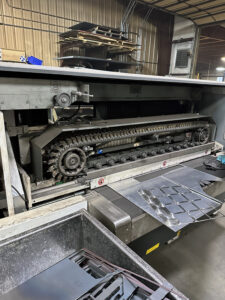Deburring and Oxide Removal
Lissmac
60″ Lissmac SBM-B 1500 Oxide Removal Machine, 2007 #784
Lissmac SBM-S 1000 Burr Removal Machine, 2008 #785
Timesavers
37″ Timesavers LYNX 37MWT-DB-60 Belt Sander, 2014 #719
Timesavers Model 3131-13-044 Wet Process Machine, 2011 #835
Deburring and Oxide Removal
In manufacturing, deburring and oxide removal are key parts of completing a project. There are numerous processing methods that frequently result in burrs, including milling, lathing, drilling, boring, cutting, grinding, laser cutting, electrical discharge machining, and others. When it comes to oxides, iron atoms in metal react with oxygen molecules in the environment to generate iron oxide, sometimes referred to as rust, when exposed to any kind of moisture, including air humidity. Any iron-containing metal, such as steel, iron, and cast iron, is susceptible to rust.
Examples of Oxides in Metal Fabrication
Iron oxide, cobalt oxide, chrome oxide, copper oxide, manganese dioxide, and nickel oxide are common metal oxide compounds. Some of these, including cobalt, copper, and nickel, can be found in carbonate forms. Some minerals, like cobalt and chromium, provide predictable and steady color contributions.
What is Oxidation Removal?

Oxide Removal/Grinding Machine
In metal finishing, the removal of the oxide layer on the cut edge of a metal part is an important step that makes the part ready for additional processes like coating. Paint will stick better, protecting against corrosion. A deburring machine, which can be customized to meet the needs of various industries, can successfully remove the oxide layer on the inner and outer edges of laser-cut steel components.
Oxide Removal Methods in Metal Fabrication
The presence of oxides on the surface of metals can compromise the final product’s quality and integrity during metal manufacturing. When a metal is exposed to oxygen and moisture, oxides, often known as rust or scale, form. To preserve the structural integrity, aesthetic appeal, and performance of the metal, it is imperative to remove these oxides throughout the production process. The kind of metal, the thickness of the oxide deposit, the complexity of the component, and economic considerations all play a role in choosing the best oxide removal technique.
Examples of Burring
During the metal fabrication process, metal burrs may occur along the many stages of fabrication. A metal burr can be thought of as a rough or bumpy inclusion on a piece of metal. Additionally, rough or sharp edges on a piece of metal are examples of what may also be classified as metal burrs. These metal burrs can occur from the various machines and processes used during fabrication. Removing the burrs through a deburring process may be essential to the continuation of the fabrication process for metal components.
What is Deburring?
Deburring plays a vital role in improving the quality, safety, and functionality of metal components, making it an essential step in the fabrication and production of metal products. In this procedure, any burrs, sharp edges, or other imperfections that may have remained after a metal component has been cut, sculpted, or machined are removed. To accomplish this deburring, a variety of techniques and deburring machines are used, each tailored to particular materials and specifications. Deburring properly is essential to the overall performance and dependability of metal-based goods in a variety of industries.
Burring Removal Methods

Burr Removal Machine
In order to guarantee the end product’s quality, safety, and functionality, burring removal is a crucial stage in the production of metal. When removing a burr from a very large component, a machine operator may be able to remove a burr without any issues, however, if the part is smaller, they might not be able to do so without impairing the part’s functionality. Choosing the right method and machine function for your needs is an important consideration for your business. Examples of deburring methods include mechanical deburring, abrasive blasting, grinding, brushing, tumbling, and other manual deburring techniques. There are also ultrasonic, chemical, and thermal methods.
Depending on the material being processed, the intricacy of the component, the volume of production, and the required final quality, the burring removal method is going to be selected. The most ideal results are frequently obtained by combining many techniques. Effective burr removal ensures that metal components fit correctly, operate well, and are safe, in addition to improving their appearance.
Prioritizing Deburring and Oxide Removal
In order to guarantee that the final products meet stringent standards for appearance, usability, and safety, deburring and oxide removal are essential stages. Manufacturers may consistently meet or exceed customer expectations while upholding the highest standards of quality and performance by giving these procedures top priority.
Contact us here to speak to a member of our team of experts. At Elite Machinery, we are here to help you find the oxidation removal or deburring machine that your business requires.

